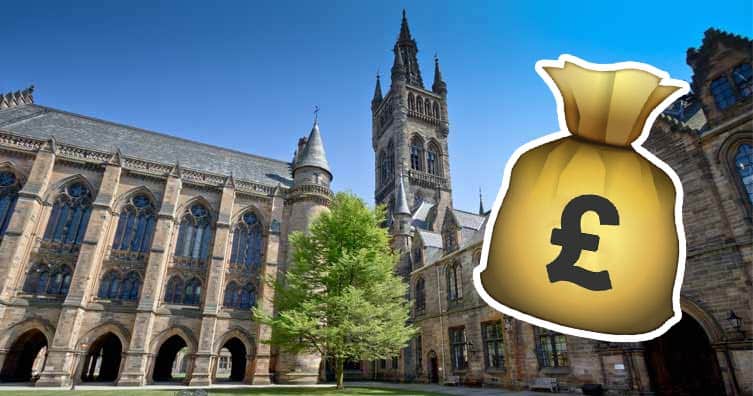Student Finance in Scotland 2025
Trying to wrap your head around Scottish Student Finance? We've done the hard work for you and put together everything you need to know – minus the jargon.

Depending on which part of the UK you're from, your Student Finance package will be slightly different – and Scotland happens to have a particularly generous funding system.
You might have heard that Scottish students have free tuition fees – and that's true if you decide to study in Scotland and meet the criteria.
Here, we'll talk you through all the key info you need to know, including how much funding you can receive as a Scottish student, how to apply and when you need to start repaying your loan.
What's in this guide?
Student Finance Scotland: A brief overview
As a brief overview, these are the key things to know about Student Finance in Scotland:
- Unlike the rest of the UK, most Scottish degrees take four years to complete.
- The body for Student Finance in Scotland is the Student Awards Agency Scotland (SAAS).
- Most first-time students can get funding to pay for university tuition fees – you won't need to pay upfront.
- Scottish students can study for free in Scotland – the government picks up the tab for tuition fees.
- However, students from the rest of the UK will be charged up to £9,250 for tuition fees in Scotland.
- There's cash to cover living costs for Scottish students in the form of the Student Loan and bursaries.
- If you receive the Student Loan, you only start repaying it once you've left your course and are earning enough (and if your income drops, so will your repayments).
- Any debt you haven't cleared after 30 years is written off.
- Student Finance may not go as far as you think it will. Get a clear idea of the costs, and how you'll cover them – this guide will help.
Is university free in Scotland?

Credit: Henning Marquardt - Shutterstock
University is free in Scotland, but only if you're a student from Scotland (or from the EU, and started in the 2020/21 academic year or earlier). If that's you, you won't pay a penny towards tuition fees at Scottish universities – the Student Awards Agency Scotland (SAAS) will cover the £1,820 a year for you.
This also means that if you're one of these students, but you aren't eligible for the fees waiver for whatever reason, you'll still get a much cheaper deal than you would if you studied elsewhere in the UK.
For students from the Rest of the UK (RUK) – England, Northern Ireland and Wales – and the Republic of Ireland (who are charged RUK fees), it's less of a bargain. Full-time RUK university fees in Scotland cost up to £9,250 a year.
International students (including those from the EU who started from 2021/22 onwards), are generally charged a fair bit more, with fees potentially costing around £25,000 – £35,000.
Don't forget that tuition fees are only one part of the full university package. You'll also need to pay for:
- Monthly rent
- Household bills
- Public transport
- Food shops
- Extra course costs (like lab kits, field trips and work experience).
Don't panic though – stick all your estimated costs into a budget planner to avoid stressful surprises later on. We've got your back with our budgeting guide.
How long do you have to live in Scotland to get free tuition fees?
Firstly, to be eligible to have your tuition fees in Scotland covered by SAAS, you need to have lived somewhere in the United Kingdom for at least three years before the course starts. In addition to this, you need to be ordinarily resident in Scotland.
Despite what you might hope, this doesn't mean you can move to Scotland the day before your course starts and still be eligible for the free fees. It basically means you need to live in Scotland permanently, year after year, full-time and only leaving for holidays – there's just no set time frame on it.
If you plan on moving there solely for your education, this will likely not qualify you for the free tuition fees.
Four-year degrees in Scotland
A standard honours degree in Scotland lasts four years, as opposed to three years like in the rest of the UK. What's more, many Scottish students go to university aged 17, unlike students in England and elsewhere who generally go at 18.
Essentially, this doesn't mean anything other than an extra year of loans to take into consideration. You'll still graduate with the same qualification as you would elsewhere.
However, if you're studying a subject in humanities or social sciences, and you're attending one of the ancient universities (University of St Andrews, University of Edinburgh, etc.), you might leave with a Master of Arts. This differs from the Bachelor of Arts you would get at most universities in the rest of the UK.
Even though you're getting a master's qualification, this isn't the same as a postgraduate MA – it's still an undergraduate degree.
A few institutions offer accelerated courses, which get you in and out in three years (say goodbye to long vacations!). Alternatively, a 'general' (non-honours) degree takes just three years but isn't as specialised.
Suss it out before you opt for a cheaper or faster route – make sure you're getting the degree you want.
Student Finance in Scotland

Credit: Watchara Ritjan – Shutterstock
Each country in the UK is different when it comes to Student Finance, so whether you're from England, Northern Ireland, Wales or Scotland, you'll be eligible for different kinds of funding.
As stated earlier, students from the rest of the UK and the Republic of Ireland will be charged up to £9,250 a year for studying in Scotland, but this will be covered by a loan that you pay back after graduation. Find out more in our guide to Student Finance.
All the information below is specifically for Scottish or Irish students applying for Student Finance through SAAS. However, if you're an Irish student, your eligibility criteria will be different and you won't receive a fee waiver, despite applying to the same funding body as Scottish students.
Students from the rest of the UK must apply for Student Finance through their relevant body.
Eligibility for Student Finance
To qualify for all three of the free tuition fees, Student Loan and bursaries, you must meet the SAAS eligibility criteria:
- You have lived in the UK for at least three years prior to the start of your course
- You are 'ordinarily' resident in Scotland on a specified date (typically 1st August for courses starting in the autumn term)
- You have 'settled status' in the UK on the relevant date.
This means you must live in Scotland full-time and out of choice, not just for your education.
There are some exceptions to the rule, however, such as Irish students, those with refugee status and more – these groups may still be eligible for some funding. Check the SAAS website for more information about this.
Other than that, the main part of the eligibility criteria is that this must be your first degree. If you tick the boxes, then you're good to go.
Tuition fees
Most students who live in Scotland full-time won't have to pay anything for tuition fees because the Scottish government stumps up the cash for you.
Full-time and part-time Scottish students studying at a university in Scotland can benefit from the fee waiver. The money doesn't have to be repaid, but check with SAAS for all the details.
As for EU students, you must have started your course in 2020/21 or earlier, and have been a resident of the UK for at least three years prior to the start of university to be given financial support for living costs.
Do Scottish students have to pay for university in England?
The sting in the tail: if you're a Scottish student and you want to study elsewhere in the UK, you'll forfeit your free tuition fees cash and can be charged up to £9,250 a year for your course.
That doesn't mean you have to put down any money straight away, though. If you're eligible for Student Finance you can get a Tuition Fee Loan, which you don't have to pay back until you've left your course and are earning enough.
Student Loans
Your main funding source for your university living costs will come from the SAAS Student Loan.
It is partly based on your household income, although if you don't want to provide any income details you'll still receive a minimum of £8,400 a year.
It's usually paid in monthly instalments directly to your bank account, although you should receive the first and second payments together as a double payment. Like any other loan, you will have to pay it back eventually, but we'll get to that later.
Bursaries
Bursaries are free money, meaning you don't have to pay them back. These are dependent on your household income, and you'll receive them in addition to the Student Loan.
How much you're entitled to depends on whether you're classed as a Young Student (meaning you're under the age of 25 and you're not married, a parent or financially independent), or an Independent Student.
Independent Students will receive £1,000 a year if their household income is £20,999 or less, whereas Young Students receive a sliding scale of money depending on their household income (see table below).
The cash is paid directly into your student bank account in instalments.
Taking both the Student Loan and bursaries into consideration, here's how much Young Students can receive depending on their household income:
Student Loan and bursary for Scottish students 2024/25
| Household income | Loan | Bursary | Total* |
|---|---|---|---|
| £20,999 or less | £9,400 | £2,000 | £11,400 |
| £21,000 to £23,999 | £9,400 | £1,125 | £10,525 |
| £24,000 to £33,999 | £9,400 | £500 | £9,900 |
| £34,000+ | £8,400 | £0 | £8,400 |
This table applies to Young Students.
Part-time students aren't eligible for funding to cover living costs (but check out the extra funding sources below).
Other funding sources for Scottish students

UK students have access to extra support for specific circumstances, including:
- Lone Parents' Grant for help with childcare costs.
- Dependants' Grant if you're financially responsible for another adult you live with.
- Disabled Students' Allowances (DSA) for things like specialist equipment, a non-medical helper and travel expenses if you're unable to use public transport.
- Travel expenses for health profession courses.
- Bursary and accommodation grant for care-experienced students.
- Funding for Nursing and Midwifery courses in Scotland. This includes a non-repayable bursary of up to £10,000, £60 in initial expenses, plus maintenance support for special circumstances.
Start with your country's Student Finance portal to find out what exactly is on offer where you are (and how to get it). But remember there's plenty in the pot if you know where to look such as:
- University bursaries and scholarships, plus hardship funds for students who might struggle to afford uni (or to get by once they're there)
- Business sponsorships, government incentives and charity funds
- Course-specific support, including teacher training and social work.
It's also worth talking to your university. They'll have dedicated advisers who can point you in the direction of travel grants, discounts, scholarships and emotional support.
When to apply for Student Finance through SAAS
Our best advice here is to apply for Student Finance as early as possible.
You don't need to wait until you receive your exam results to apply for Student Finance. Simply apply using the details of your first choice university and course.
If things turn out differently after results day, you can easily contact SAAS to change things over to a different university.
It's recommended that you apply for Student Finance by the end of June before starting uni. This way, SAAS should be able to process your application before the term starts. Apply any time after this and you could get your Student Loan late, leaving you short during freshers' week.
Remember that you need to reapply for funding every year of your course. It doesn't automatically roll over.
Repaying your Scottish Student Loan
For students from elsewhere in the UK (England, Northern Ireland or Wales), your Student Loan repayments will be different to what's outlined below.
If SAAS covers your tuition fees, the only loan you need to worry about repaying is the Student Loan for your living costs.
As with all Student Loans, you don't need to worry about repaying any money until you've finished your course.
But you should know that the loan starts brewing interest from day one up until you clear the final payment (or the debt is wiped), so you'll end up owing more than you actually borrowed.
The Student Loan in Scotland has been part of the Plan 4 system since 6th April 2021 (it was previously Plan 1), and the interest rate is currently set at 4.3%.
You don't start repaying your loan until the April after your graduation and when you're earning more than £31,395 (£2,616/month) in taxable income.
Once you hit the threshold, repayments are automatically docked from your wages before you get paid (unless you're self-employed, in which case it's calculated when you complete your tax return each year). Either way, you pay 9% on anything you earn above the threshold (not your whole salary).
Crucially, if your income falls below the threshold at any time, repayments stop until you're back over the line.
Monthly repayments of your Student Loan
| Annual salary | Plan 4 monthly repayments (6th April 2024 – 5th April 2025) |
|---|---|
| £31,395 | £0 |
| £40,000 | £65 |
| £50,000 | £140 |
| £60,000 | £215 |
| £70,000 | £290 |
| £80,000 | £365 |
| £90,000 | £440 |
| £100,000 | £515 |
Above are some examples of what your monthly repayments could look like.
You don't have to stick to these repayments if you don't want to, as this is just the minimum amount you have to repay. You can pay more, or pay it off in full at any time – but whether it's worth it is questionable!
Since the debt will be wiped after 30 years, it might not be worth paying it off before then, especially if you don't think you'll earn enough to pay the full sum with the minimum repayments.
Use our Student Loan Repayment Calculator to see whether you're likely to pay yours off.








